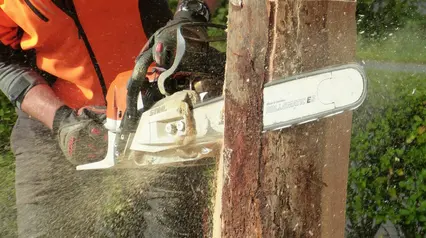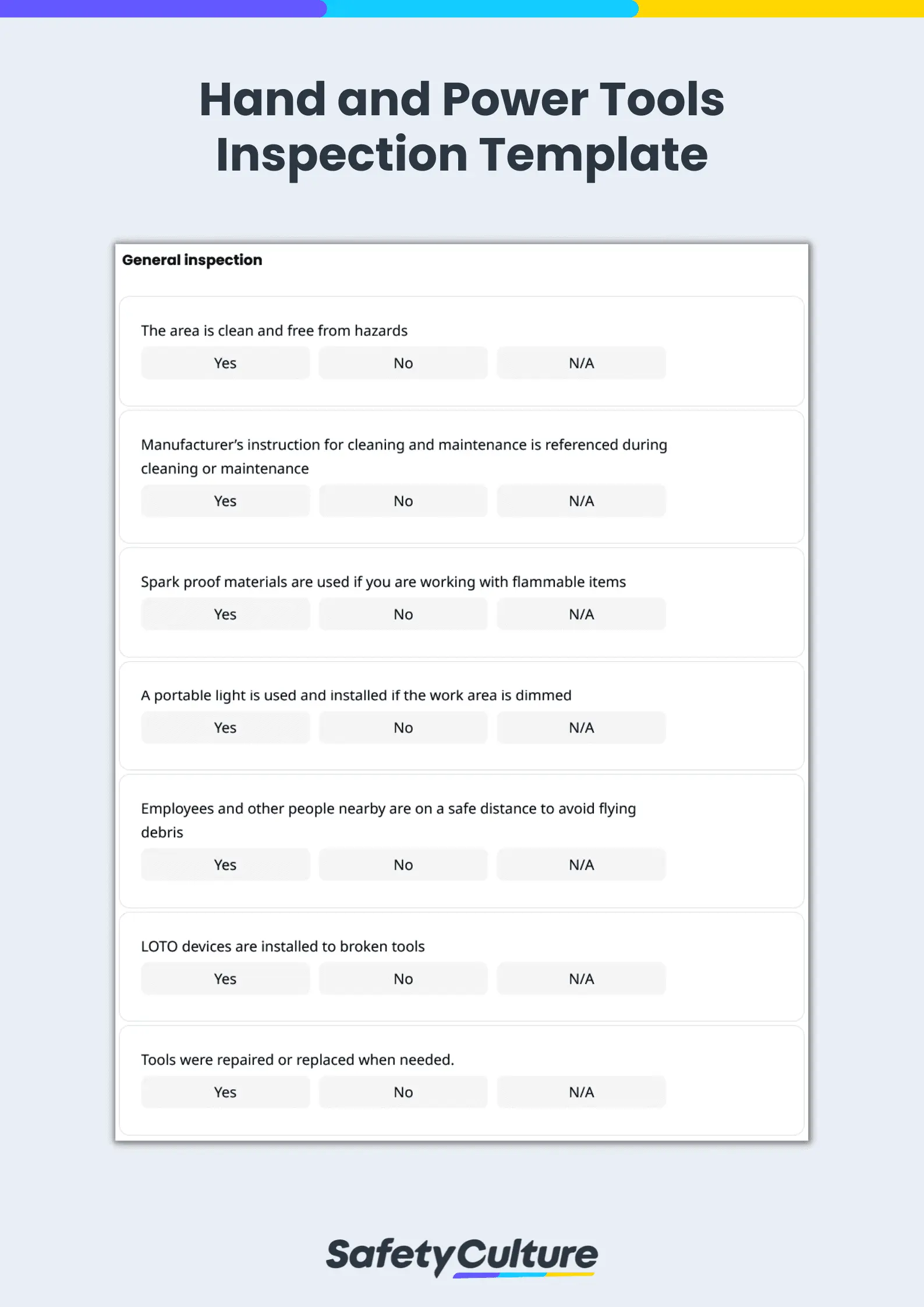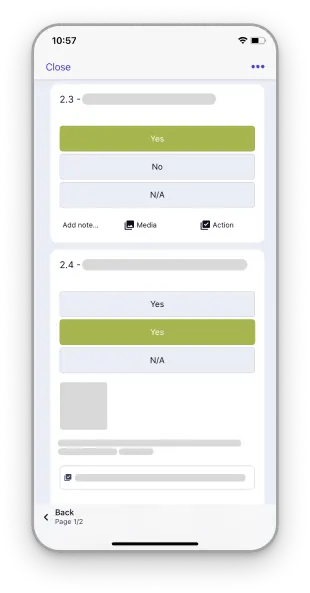What is a Hand and Power Tool Safety Checklist?
A hand and power tool safety checklist is a comprehensive and useful tool that outlines guidelines and precautions designed to ensure the safe and proper use of hand tools and power tools in various work settings. Using this checklist, individuals and organizations can promote a safer working environment, reduce the likelihood of accidents, and ensure that tools are used effectively and responsibly.
Importance of Using One
Hand and power tools refer to manual and electric-powered tools, respectively, designed to assist construction workers, carpenters, and other manual laborers in the performance of work. Below are some of the most widely used hand and power tools for workers in different industries:
- Hammer — used in almost all professional and amateur construction work
- Power Drill — used to drill holes through wood, plastic, thin metal, and masonry
- Wire Cutters — used to cut wires of varying materials, including copper, brass, iron, aluminum, and steel
- Angle Grinder — used to polish, cut, sharpen, and sand a variety of materials including wood, metal, tiles, stucco, and pavers
- Screwdrivers — used for turning screws with slotted heads
- Chainsaw — used to cut wood and cut through brick, concrete, and stone
- Pliers — used for gripping smooth, round surfaces or for twisting and even cutting certain types of wire
While hand and power tools are a big help, they pose various physical hazards that can cause both minor and major injuries if not guarded against. This is why you must utilize a pre-use safety inspection checklist to check the condition of these tools before operation. It serves as a proactive measure to prevent accidents, injuries, and potential hazards associated with the use of tools in the workplace. The checklist also acts as a systematic guide, ensuring that users adhere to safety protocols, proper tool-handling techniques, and necessary preventive measures.
By incorporating essential safety considerations, organizations not only prioritize the well-being of their workers but also contribute to the overall efficiency, productivity, and longevity of hand and power tools.
What to Include in a Hand and Power Tool Safety Checklist
Creating an effective and comprehensive checklist to help minimize the risk of accidents and injuries associated with the use of hand and power tools can ensure that workers are equipped with the knowledge and resources needed to handle them safely. The following are the key elements you must include in it:
- Title Page
- General Inspection
- Employee Condition and Training
- Hand Tools Inspection
- Power Tools Inspection
- Summary of Repairs and Replacements
- Completion and Sign-off
How to Use a Safety Checklist for Hand and Power Tool Pre-Use
It’s important to create and use a hand and power tool safety checklist to maintain a secure work environment, identify potential hazards, promote adherence to safety protocols, and minimize the risk of accidents. Here’s a step-by-step guide you can follow when using one in your organization:
- List all hand and power tools used in the workplace and describe the task/s being carried out.
- Assess the characteristics of the work environment, accounting for potential hazards related to the specific workspace.
- Conduct visual checks, safety inspections, and operational tests for wear, damage, and proper functioning of hand and power tools.
- Ensure employees are wearing proper PPEs when using hand and power tools.
- Establish a schedule for reviewing and updating the checklist and reflect changes in tools, tasks, or regulations promptly.
5 Basic Rules of Hand and Power Tool Safety
Due to the inherent hazards involved, workers and safety professionals must ensure that the correct safety measures are consistently implemented before, during, and after using hand and power tools. Hence, here are the five basic safety rules to prevent hazards they may face according to the US Occupational Safety and Health Administration (OSHA):
- Keep all tools in good condition with regular maintenance — Inspection of tools should be done regularly to lower the risk of injuries due to malfunctioning equipment and to prevent unexpected downtimes that negatively impact operational efficiency.
- Use the right tool for the job — Choosing the appropriate tool for the job is necessary to avoid incidents and injuries.
- Examine each tool for damage before use and do not use damaged tools — Employers must ensure that employees never use damaged tools. Equipment should help employees easily perform their tasks and not put them in danger.
- Operate tools according to the manufacturers’ instructions — Employees should read and comply with manufacturers’ guides to avoid mishandling tools that lead to otherwise avoidable accidents.
- Provide proper PPE — All employees are expected to wear appropriate PPE when working around flammable gases, volatile liquids, or other explosive materials to avoid physical contact with combustible materials, which can cause burns, blindness, or respiratory and skin diseases.
For further guidance, the following standards apply to specific jurisdictions:
- Safe Work Australia — In Australia, the model Work Health and Safety (WHS) regulations provide guidelines for the use of hand and power tools, covering aspects like risk assessments, training, and the provision of safe work environments.
- Health and Safety Executive (HSE) — In the UK, the HSE’s regulations, such as the Provision and Use of Work Equipment Regulations (PUWER), address the safe use of tools, including requirements for equipment maintenance, user training, and risk assessments.
- European Union (Machinery Directive) — The EU’s Machinery Directive sets essential health and safety requirements for machinery, including hand and power tools. Manufacturers must comply with these requirements when placing machinery on the EU market.
13 Safety Precautions to Follow When Using Hand and Power Tools
Below are some notable safety precautions to follow when using hand and power tools:
- Do not use power tools unless you have proper training.
- Work in a spacious area and be aware of the people around you.
- When working at heights, use a bucket or bag to hoist tools from the ground.
- Use a toolbox when carrying pointed tools. Do not put them in your pocket.
- Report damaged tools immediately.
- Carry power tools carefully and not by their cables.
- Check weather conditions when working with electric tools outside.
- Do not play with hand and power tools.
- Compressed air guns should not be pointed at yourself or another person.
- Clean your working area and tools before leaving the workplace.
- Do not leave power tools plugged if unattended.
- Electric power tools must be double-insulated or properly grounded.
- Electric tools or equipment should be repaired only by qualified persons.
FAQs About Hand and Power Tool Safety Checklists
The requirement for a hand and power tool safety checklist in workplaces is often dictated by occupational health and safety regulations. In many jurisdictions, such as the US, Australia, the United Kingdom, and European Union member states, some specific regulations and standards mandate employers to ensure a safe working environment. This may include the use of hand and power tools.
A hand and power tool safety checklist can prevent ergonomic injuries by promoting proper tool selection, usage techniques, and the use of personal protective equipment. It also addresses factors such as workstation ergonomics, regular breaks, and maintenance practices, collectively minimizing strain on the body and reducing the risk of musculoskeletal disorders.
Yes, a hand and power tool safety checklist can be adapted for conducting maintenance by incorporating visual inspections, cleaning, lubrication, blade sharpening, and functional testing. Including these steps in the checklist ensures tools are regularly checked, promoting longevity, optimal performance, and overall safety.




